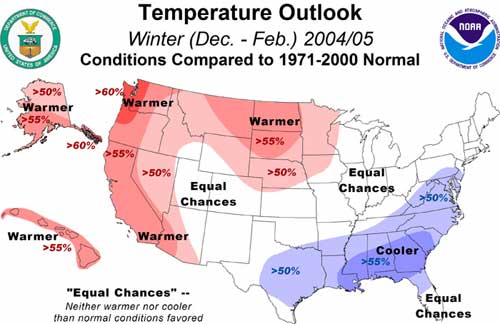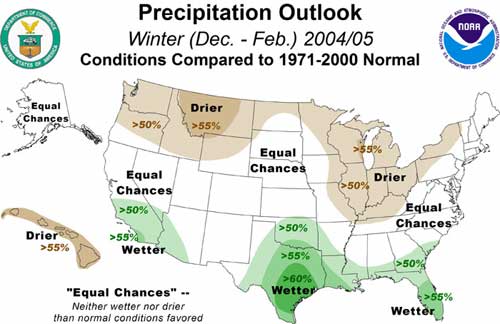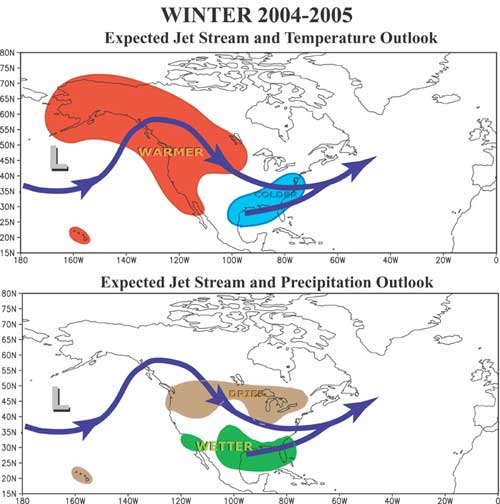 Above-Average Temperatures in Alaska October 07, 2004
The NOAA 2004-2005 Winter Outlook calls for above-average temperatures in Alaska, much of the West and the northern and central Great Plains. Below average temperatures are expected across the Gulf Coast states, the Southeast and the mid-Atlantic region of the U.S. There are equal chances of warmer, cooler or near-normal temperatures this winter in the Northeast, Midwest and parts of Southwest. 
The winter outlook indicates some improvement in drought conditions in the West, but long-term drought is expected to persist through the winter in many areas. NOAA will update its winter outlook on Oct. 21st. The winter outlook reflects a blend of impacts associated with weak-to-moderate El Niño events in the central equatorial Pacific Ocean and is based on the likelihood that these conditions will persist through early 2005. El Niño influences the winter weather patterns by affecting the jet stream and the track storms take across the eastern Pacific and North America. NOAA scientists do not expect this El Niño to reach the strength of the1997-1998 El Niño event. "Our winter forecast factors-in the effects of a weak El Niño that may strengthen into a moderate event during the winter months," said retired Navy Vice Adm. Conrad C. Lautenbacher, Ph.D., under secretary of commerce for oceans and atmosphere and NOAA administrator. "But we'll keep our eye on other climate features in the Pacific and the North Atlantic that play an important role on the week-to-week variability in our winter weather. These patterns influence the position of the jet stream and dictate where and how winter storms will move." 
Also, the climate system called the North Atlantic Oscillation plays an important role in modulating the winter weather over the eastern half of the U.S. The NAO is a climate pattern that influences the position of the jet stream over the North Atlantic, affecting winter weather over the Northeast. "To a large extent, our forecast of equal chances of above or below normal temperatures and precipitation over the northeastern U.S. is based on the NAO, which is only confidently predicted one to two weeks in advance," said Ed O'Lenic, meteorologist at NOAA's Climate Prediction Center. Impacts from the NAO are included in NOAA's Climate Prediction Center's 8-14 day and 6-10 day outlooks and U.S. Hazards Assessment. 
"NOAA's progress in climate forecasting is based on ongoing research and collaboration with our partners, advancements in our understanding of the global climate system, upgrades to the weather and climate supercomputer, and improvements in the state-of-the-art atmospheric and oceanic modeling applications. The knowledge and understanding NOAA gains is allowing us to begin a new era in climate prediction," said Dr. Louis W. Uccellini, director of NOAA's National Centers for Environmental Prediction. NOAA is an agency of the U.S. Department of Commerce.
Source of News & Graphics:
|